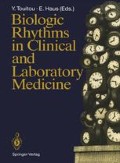Abstract
Despite the lessons to be learned from the thalidomide disaster some 20 years ago, recent studies indicate that pregnant women are still consuming therapeutic agents in alarming quantities. Moreover the developmental risks imposed by the maternal use of substances of abuse are, perhaps more than many other risk factors, preventable. The etiology of human malformations includes both (1) genetic factors and (2) drugs and environmental agents (for established teratogens see Brendel et al. 1985).
Access this chapter
Tax calculation will be finalised at checkout
Purchases are for personal use only
Preview
Unable to display preview. Download preview PDF.
References
Abel El (1984) Fetal alcohol syndrome. Fetal alcohol effects. Plenum, New York
Abel El (1985) Prenatal effects of alcohol on growth: a brief overview. Fed Proc 14: 2318–2322
Altura BM, Altura BT, Carella A, Chatterjee M, Halevy S, Te-jani N (1982) Alcohol produces spasms of human umbilical blood vessels: relationship to fetal alcohol syndrome (FAS). Eur J Pharmacol 86: 311–312
Aufrere G, LeBourhis B (1987) Effect of alcohol intoxication during pregnancy on foetal and placental weight: experimental studies. Alcohol Alcohol 22: 401–407
Brendel K, Duhamel RC, Shepard TH (1985) Embryotoxic drugs. Biol Res Pregnancy 6:1–54
Chernoff N, Rogers JM, Alles AJ, Zucker RM, Elstein KH, Massero EJ, Sulik KK (1989) Cell cycle alterations and cell death in cyclophosphamide teratogenesis. Teratogenesis Car-cinog Mutagen 9:199–209
Clayton DL, Mullen AW, Barnett CC (1975) Circadian modification of drug-induced teratogenesis in rat fetuses. Chrono-biologia 2: 210–217
Endo A, Sakai N, Ohwada K (1987) Analysis of diurnal differences in teratogen (Ara-C) susceptibility in mouse embryos by a progressive phase-shift method. Teratogenesis Carcinog Mutagen 7: 475–182
Guerri C, Sanchis R (1985) Acetaldehyde and alcohol levels in pregnant rats and their fetuses. Alcohol 2: 267–270
Hales BF, Slott VL (1987) The role of reactive metabolites in drug-induced teratogenesis. Prog Clin Biol Res 253:181–191
Isaacson RJ (1959) Investigation of some of the factors involved in the closure of the secondary palate. Thesis, Minnesota University, Minneapolis
Jones JH, Leichter J, Lee M (1981) Placental blood in rats fed alcohol before and during gestation. Life Sci 29:1153–1159
Jones KL, Smith DW (1973) Recognition of the fetal alcohol syndrome in early infancy. Lancet 2: 999–1001
Reinberg A, Smolensky MH (1983) Biological rhythms and medicine. Springer, Berlin Heidelberg New York
Sauerbier I (1981) Circadian system and teratogenicity of cytostatic drugs. Prog Clin Res 59 C: 143–149
Sauerbier I (1982) Unterschiedliche Konzeptionsfahigkeit der weiblichen Han: NMRI Maus. Einfluβ der Verpaarung am Abend und am Morgen. Z Versuchstierkd 23:161–164
Sauerbier I (1983) Embryotoxische Wirkung von Zytostatika in Abhangigkeit von der Tageszeit der Applikation bei Mausen. Verh Anat Ges 77:147–149
Sauerbier I (1986 a) Circadian variation in teratogenic response to dexamethasone in mice. Drug Chem Toxicol 9: 25–31
Sauerbier I (1986 b) Circadian modification of 5-fluorouracil-induced teratogenesis in mice. Chronobiol Int 3:161–164
Sauerbier I (1987) Circadian modification of ethanol damage in utero in mice. Am J Anat 178:170–174
Sauerbier I (1988) Circadian influence on ethanol-induced intrauterine growth retardation in mice. Chronobiol Int 5: 211–216
Sauerbier I (1989) Embryotoxicity of drugs: possible mechanisms of action. In: Lemmer B (ed) Chronopharmacology. Cellular and biochemical interactions. Dekker, New York, pp 683–697 (Cellular clocks, vol 3)
Savoy-Moore RT, Dombrowski MP, Cheng A, Abel EA, Sokol RJ (1989) Low dose alcohol contracts the human umbilical artery in vitro. Alcoholism (NY) 13: 40–42
Schmidt R (1978) Zur zirkadianen Modifikation der pranatal-toxischen Wirkung von Cyclophosphamid. Biol Rundsch 16: 243–248
Sessa A, Desiderio MA, Perin A (1987) Ethanol and poly amine metabolism in adult and fetal tissues: possible implication in fetus damage. Adv Alcohol Subst Abuse 6: 73–85
Sturtevant RP, Garber SL (1985) Circadian exposure to ethanol affects the severity of cerebellar cell dysgenesis. Anat Rec 211:187
Sturtevant RP, Garber SL (1986) Chronopharmacology of ethanol: acute and chronic administration in the rat. Annu Rev Chronopharmacol 4: 47–76
Walker AM, Oakes GK, McLanghlin MK, Ehrenkranz RA, Chez RA, Ailing DW (1977) 24-hr rhythms in uterine and umbilical blood flows of conscious pregnant sheep. Gynecol Invest 8: 288–298
Walsh SW, Ducsay CA, Novy MJ (1984) Circadian hormonal interactions among the mother, fetus and amniotic fluid. Am J Obstet Gynecol 150: 745–753
Editor information
Editors and Affiliations
Rights and permissions
Copyright information
© 1992 Springer-Verlag Berlin Heidelberg
About this chapter
Cite this chapter
Sauerbier, I. (1992). Rhythms in Drug-Induced Teratogenesis. In: Touitou, Y., Haus, E. (eds) Biologic Rhythms in Clinical and Laboratory Medicine. Springer, Berlin, Heidelberg. https://doi.org/10.1007/978-3-642-78734-8_10
Download citation
DOI: https://doi.org/10.1007/978-3-642-78734-8_10
Publisher Name: Springer, Berlin, Heidelberg
Print ISBN: 978-3-642-78736-2
Online ISBN: 978-3-642-78734-8
eBook Packages: Springer Book Archive

